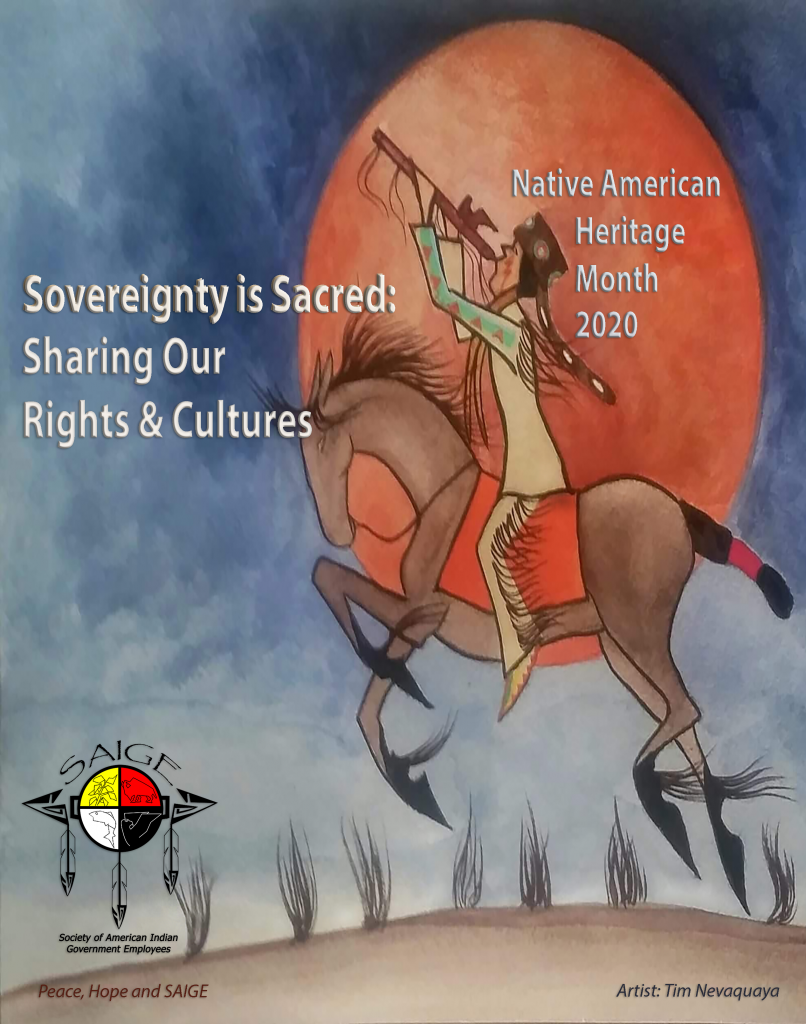Federally Employed Women proudly recognizes Native American Alaska Native Heritage Month. The 2020 National theme is Sovereignty is Sacred: Sharing Our Rights & Cultures.

One of earliest recorded attempts to create a day of recognition for the contributions of “First Americans” dates back to 1912, when Dr. Arthur Caswell Parker (Seneca Nation), who founded several Indian rights organizations, persuaded the Boy Scouts of America to recognize “First Americans” Day, which they did for three years. The first American Indian Day was celebrated in New York, May 1916. The effort was led by a member of the Blackfeet Nation, Red Fox James, who rode across the nation on horseback seeking approval from 24 state governments to have a day to honor American Indians. In 1990, President George H.W. Bush signed a joint congressional resolution designating the month of November “National American Indian Heritage Month.”
Special observances such as Native American Alaska Native Heritage Month were designed for the purpose of providing cultural awareness to everyone. The month of November has been designated to celebrate the rich and diverse cultures, traditions, and to acknowledge the important contributions of America’s indigenous people. Commemorative activities conducted for special observance months should be educational and inclusive. As the National theme suggests, autonomy is extremely important to Native Americans, but it is also very important for us to help them preserve traditions and share their history and culture. Connection to history is essential because it establishes a sense of identity and belonging. There is so much that we can learn from Native American’s deep respect for the earth and harmony with nature, the cycle of all living things, and the love and respect for family and community.
There are many resources available to find programs and activities. The Society of American Indian Government Employees is a constant resource throughout the year. During the month of November, Saige will be hosting several virtual programs and commemorative events. Please visit www.saige.org and share the events with your chapter/region members.
Also during the month, the Library of Congress, National Archives and Records Administration, National Endowment for the Humanities, National Gallery of Art, National Park Service, Smithsonian Institution and United States Holocaust Memorial Museum will join in paying tribute to the rich ancestry and traditions of Native Americans.
Please check out https://nativeamericanheritagemonth.gov/ for a calendar of events
About the Artist: Timothy Tate NEVAQUAYA
Timothy Tate Nevaquaya is a Comanche and Chickasaw/Choctaw artist, veteran, and minister from Apache, Oklahoma. The son of the late Comanche master artist and flutist, Doc Tate Nevaquaya and his wife Charlotte Foraker-Nevaquaya, Timothy’s art career began at the foot of his father’s drafting table, as a child. His early education included receiving direction from his father in the basic fundamentals of Native American art
forms, as well as flute making. These early experiences began his dance with Native American art, Native American flute, and Native American history and culture with a strong emphasis on Comanche history. As a youth, he was witness to some of the greatest Southern Plains and other Native American artists from his father’s contemporary circle of friends and colleagues. He has been a part of the reemergence of the Native American flute culture. As a young man, he participated in many of his father’s lectures and demonstrations on the flute. At age 12, he began to compose music on his father’s flutes; at age 14 he began making the flutes.
Early in his career, he immersed himself in the history of the Comanche people through independent studies. He began painting in the flat two-dimensional style reminiscent of the Southern Plains artists before him. As time went along he transitioned into a western American realism style. After many years of hard work and devotion to his art, it was in 2007, that he found his signature style, which can be characterized as, “an accident
on the canvas.” This happy mistake is where the door opened up and led to a great revelation in his artwork and in thought, and which changed the course of his life and his work. After working tirelessly on an Apache Mountain spirit piece at his home studio one night, he smudged the paints on his canvas, which created, “a happy accident.” “I remember smacking the canvas with my paintbrush and it was loaded with paint. I became incredibly frustrated, but through this mistake is when that great door opened up. I saw a different and abstract appearance in my work.” So began the journey with Nevaquaya’s latest style, which is his personal expression of movement and form in contemporary Native American art.
Nevaquaya has performed and shown his work in places such as the Smithsonian National Museum of the American Indian, The Gilcrease Museum of Western Art, The Philbrook Museum, the Oklahoma Governor’s Ball, the Oklahoma State Capitol, The University of Oklahoma, The Great Plains Museum, the Southern Plains Museum, the Comanche Museum other places. He owns and operates Nevaquaya Fine Arts: A Legacy Gallery in Tulsa, OK and makes his home in Apache, Eagletown, and Tulsa Oklahoma
with his sons.


